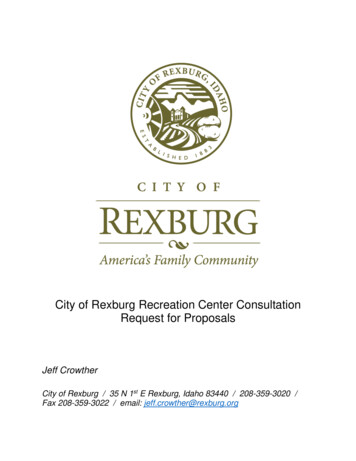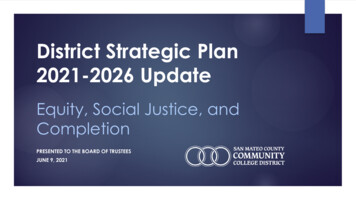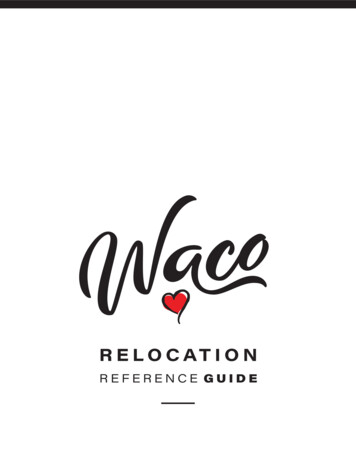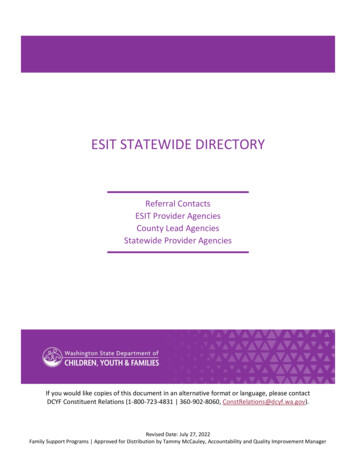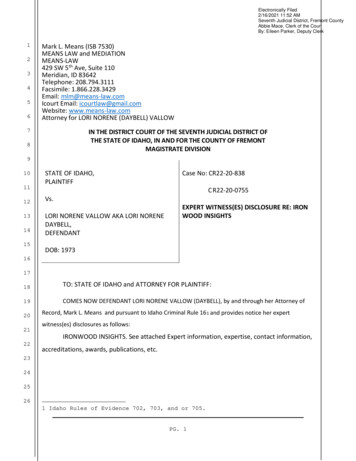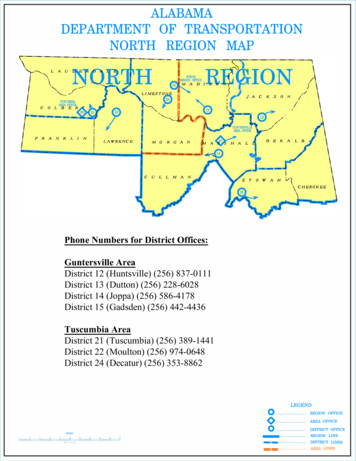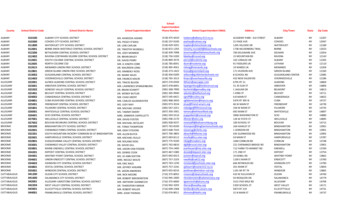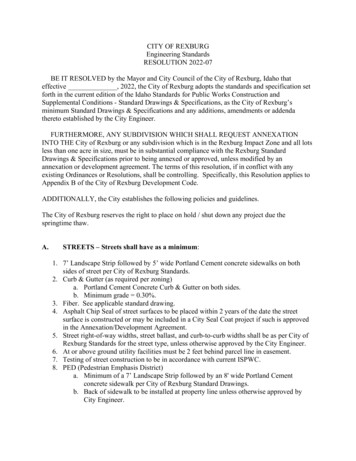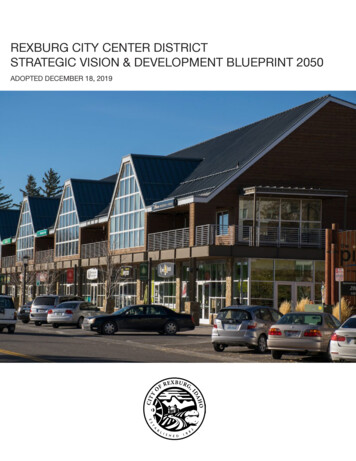
Transcription
REXBURG CITY CENTER DISTRICTSTRATEGIC VISION & DEVELOPMENT BLUEPRINT 2050ADOPTED DECEMBER 18, 2019
CITY CENTER REXBURG DISTRICTSTRATEGIC VISION & DEVELOPMENTBLUEPRINT 2050Elected & Appointed OfficialsMayor: Jerry MerrillRexburg City CouncilRexburg Planning & Zoning CommissionCity of Rexburg City Center Steering CommitteeCity StaffEconomic Development Director:Scott JohnsonEconomic Developer: Daniel TorresCity Planner: Alan ParkinsonPlanning Technician: William KlaverSpecial thanks to Craig Rindlisbacher & Val Christenson2 City Center Vision
EXECUTIVE SUMMARYResidents of Rexburg have chosen to live here because they enjoy the current quality of life. The preservation of their quality oflife is of the utmost importance to residents and business owners. The City of Rexburg is a community that respects its history.Rexburg views itself as a city where residents, tourists, businesses, and government come together to create an attractive,safe, and well-maintained community where people can live, learn, work, and recreate.The City Center Vision recognizes these desires, and acknowledges the following relationships between these residents,employers and employee aspirations:1. Community wants businesses,2. Businesses want talent,3. Talent wants place,So. Community needs Place.Therefore, this community needs to build great places, in Rexburg the City Center is that Place.This City Center Vision Document provides a strategy for building on existing strengths while promoting growth. This documentdefines the vision and goals collected from past planning efforts, as well as input from residents, elected leaders, and citystaff; it outlines proposed strategies identified herein to realize the Vision. This City Center Vision is based on an overarchingstatement of the community’s values and is consistent with community-formulated City Center goals.This Vision Document does not seek to limit or bind future planning efforts to the enumerated Strategies listed herein, rather, itis anticipated that the City Center Vision Strategies will serve as guide posts for the City Center Vision, and that where needed,pivots in strategies should occur.The City Center Vision describes the results of several public outreach efforts including the 2004 Downtown RexburgRevitalization Blueprint, the 2008 Vision 2020 Comprehensive Plan and the ongoing 2013-2014 Envision Madison process.The purpose of the City Center Vision is to provide a community development framework for preserving and protecting thecharacter of downtown, while allowing for appropriate new development which will preserve and enhance the City Center forfuture residents.City Center Vision 3
CONTENTSCITY CENTER VISION STATEMENT. 7CITY CENTER VISION STRATEGIES. 8PAST PLANNING EFFORTS. 10HISTORY AND DEVELOPMENTOF REXBURG’S CITYCENTER. 12COMMUNITY CHALLENGES. 14CITY CENTER VISION STRATEGIES. 18CITY CENTER PRIORITIES ANDPLANNING AREAS. 244 City Center Vision
Main Street, RexburgCity Center Vision 5
6 City Center Vision
CITY CENTER VISION STATEMENTDowntowns are iconic and powerfulsymbols of a city and often containthe most iconic landmarks, distinctivefeatures, and unique neighborhoods.In Rexburg the Downtown, or TheCity Center, is one of the oldestneighborhoods in the city, it offers rareinsights into the city’s past, presentand future. The City Center areahas an important and unique role ineconomic and social development. TheCity Center creates a critical mass ofactivities where commercial, cultural,and civic activities are concentrated. ConnectionsActivate the Street with BuildingFormsThese goals seek to realize residentsdesires of attracting high quality jobs,by creating a vibrant City Center thatcontains the diversity of activities thatwill make it a compelling place to work,live, and enjoy.In addition, most downtowns serveas the engine for local economies.However, downtowns are much morethan a profit center to cities. They alsorepresent the image and character of acity to the rest of the world. Downtownsare unique in that they are typically theonly neighborhood that belongs to, andis shared by, everyone in the region.CITY CENTER VISION STATEMENT“Rexburg’s City Center will be thecommunity and regional hub foreconomic growth and prosperity.Strengthening commercial,entertainment, cultural and publicassets creates a livable andprosperous City Center.”The goal of the City Center Vision is tomake Rexburg’s City Center a RegionalEconomic Hub. In order to realize this,the City Center Vision seeks to: Ensure a Diversity of EconomicActivitiesEncourage Living in the CityCenterBuild and Enhance Public Usesand SpacesBuild Effective PedestrianCity Center Vision 7
CITY CENTER VISION STRATEGIESThe City Center Vision Strategiesprovide a framework for therecommendations, objectives andpolicies which will ensure the successof the City Center Vision. These CityCenter Vision Strategies and Goals areoutlined below; for detailed expositionof the City Center Vision Strategies referto the individual City Center Strategiessections.1. City Center should be anAttractive and Walkable PlaceGoal: People should want to bein the City Center. City Centershould encourage this by being anattractive, walkable destination.A City Center with pedestrianscan create a safe and interestingspace.2. Diversify Economic UsesGoal: City Center should have adiverse economic base with a mixof housing, retail, office space,dining and entertainment, allcomplementing each other andmaximizing use of the City Center.3. Encourage BusinessGoal: City Center should be a placewhere small businesses and the“creative class” thrives through theclustering of supporting activities.4. Promote an Attainable CityCenterGoal: City Center should allowfor a mix of business and housingoptions.8 City Center Vision5. Improving GovernmentRegulations and ProcessesGoal: Simplify zoning and buildingregulations in the City Center toensure the types of developmentthat the City Center Visionseeks, and to make it easier fordevelopers to understand andbuild. Regulatory processes shouldbe streamlined and simplified.6. Financing Key ProjectsGoal: The City should be opento working with developers andbusinesses in applying for andsecuring funding for projects whichsupport the City Center Vision, andby working with state, county andlocal government organizationsto secure economic developmentfunds.7. Establishing On-Going PlaceManagementGoal: Ensure the continuedleadership and promotion of theDowntown through a City CenterAssociation.
City Center Community Workshop 2019Envision Madison Community Workshop 2013Envision Madison Community Workshop 2013Envision Madison Community Workshop 2013City Center Vision 9
PAST PLANNING EFFORTSThis Plan has followed the work ofprevious plans, studies and documents;as well as public involvement in theform of workshops, surveys, mappingactivities and more. These past effortsspan a time period of 2000 to 2018. Theprinciple plans or processes are: Downtown Rexburg RevitalizationBlueprint (2004)Vision 2020 Comprehensive Plan(2008)Rexburg Broadband Study (2013)Teton Regional Plan (2013 - 2015)Envision Madison (2013 - 2014,and ongoing efforts)Madison Transportation MasterPlan (2015)Parks and Trails Plans (2018)Madison Economic Partners’Entrepreneurial Eco-System (2018) Below are summaries of the documentsand their goals, objectives and policies:Downtown Rexburg RevitalizationBlueprintThe 2004 Downtown RexburgRevitalization Blueprint was createdthrough a community-based planningprocess. The Blueprint centered aroundfive key strategies. These key strategiesenvisioned public private partnershipsto realize effective results. These fivestrategies are listed below: Business DevelopmentPhysical ImprovementsOrganization and TeamworkTargeted MarketingResource Developmentcomprehensive plan is the officialstatement of the city’s legislative body(the city council) and sets forth its majorland use policiesThe 2020 Comprehensive Plandistinguishes Main Street and thedowntown area as “a destinationand civic and cultural heart of thecommunity.” The Comprehensive Planidentifies the following objective:Objective: Promote and enhance MainStreet and the downtown [sic] as adestination [as] the civic and culturalheart of the community.The Rexburg Broadband StudyThe Broadband Study was a 2013initiative that assessed existingbroadband Internet infrastructure inRexburg and surrounding counties(Madison, Fremont, Teton Counties,Idaho; and Teton County, Wyoming).The Study also compared nationaltrends in broadband infrastructure andneeds.Vision 2020 Comprehensive PlanThe following trends were identified:The Vision 2020 Comprehensive Plan isthe currently adopted comprehensiveplan for the City of Rexburg. The1. Globalization and Education:Today’s infrastructure must beready to prepare today’s children for10 City Center Visiontomorrow’s jobs.2. The Cloud: Businesses andconsumers increasingly requireapplications and services that residein the cloud. Infrastructure needs tobe robust enough to satisfy currentand future demand.3. Connectivity: In a world where anexpected three billion people willbe online and with two networkeddevices per capita, new possibilitiesfor productivity, innovation, and theflow of information will arise if thedata can be managed and madeunderstandable.The Teton View Regional PlanThe Teton View Regional Plan forSustainable Development was regionalplan sponsored by the FederalDepartment of Housing and UrbanDevelopment. This plan’s study areaincluded Madison, Fremont andTeton Counties, Idaho, as well asTeton County, Wyoming. The Planwas designed to help city and countyofficials better coordinate their land-useplanning, resource management, andcommunity development efforts. ThePlan produced 20 additional supportivestudies that plotted a realistic pathtowards economic and communitysustainability.
Envision MadisonEnvision Madison was a two-yearcommunity planning effort that soughtresident and elected leader’s input onhow they wanted Madison County todevelop over the next 30 years. Thegoal of Envision Madison was to bringthe community together in a processthat will help shape future growth.A principle concern was for the healthand vitality of the Downtown [sic].The following Community Principles(pertaining specifically to the CityCenter) were identified from the EnvisionMadison Process: A Caring and Safe CommunityProsperous Community andJobsAffordable, Convenient, andSafe CommunitiesIn addition, Envision Madisonrecommended that community leadersfocus planning efforts to concentratehigh density growth around theCity Center and the Brigham YoungUniversity-Idaho campus. This will takeadvantage of existing infrastructureand reduce the costs associated withsprawl.Madison County/City of Rexburg/Sugar City Transportation MasterPlanThe Madison County TransportationMaster Plan was a joint effort betweenthe cities of Rexburg and SugarCity, Madison County and the IdahoTransportation Department (District 6) tocreate a comprehensive transportationplan for Madison County.Three planning years were evaluated;2020, 2030, and 2040. The Plan foundthat growth will significantly influencethe roadway network and, if increasesin capacity were not to be undertaken,it will result in unacceptable congestionin the area. Several projects wereidentified which range from signal timingprojects to interchange reconstructions.The following improvements totransportation routes within the CityCenter were recommended by theTransportation Plan to keep up withanticipated growth:1. Safety Study on 2nd East from7th South to Main Street2. Safety Study on 2nd East fromMain Street to 7th North3. Main Street Safety Study (US 20to 2nd E)4. Intersection Improvements,Main Street and 2nd West5. Intersection Improvements,Main Street and 2nd East6. Reconfigure 2nd South/2ndWest Intersection7. Widen 2nd East from 7th Southto Main StreetIt is anticipated that theseimprovements should be completed by2040.Rexburg Parks and Trails PlansThe Trails Plan recommends thatplanning polices be strengthened toinclude: multimodal transportationstudies which would include bike andpedestrian alternatives to vehiculartransportation; encouraging developersto meaningfully set aside land forbicycle and pedestrian connections;ensuring that these connectionsmeaningfully connect to each other, thegreater trail network, and to commercialcenters and the to the City Center.Entrepreneurial Eco-System PlanThe City of Rexburg and MadisonEconomic Partners have developed aplan to ensure the continued economicvitality of Rexburg by laying thefoundations for an EntrepreneurialEco-System, focused on programs andfacilities in the City Center.The Plan recommends a strongentrepreneurial community, withnumerous threads woven together,supporting entrepreneurship,including: public policy, people,financing, technology, customers,and transportation. The Plan identifiesthe following characteristic as criticalto the success of an entrepreneurialcommunity:1.2.3.4.An enabling cultureSupportive infrastructureSupportive NetworksAn entrepreneur-friendlygovernmentWithin the City Center, the Planrecommends the establishment ofCo-Working space, an Incubation andBusiness Accelerator, a STEM Center,and a FAB Lab.In addition, the following trailconnections were identified whichwould connect the City Center to theRexburg Trail Network:1.2.3.4.2nd East TrailMain Street Historic Trail2nd West Trail2nd South TrailCity Center Vision 11
HISTORY AND DEVELOPMENT OFREXBURG’S CITY CENTERThe City’s history started in 1883 whena group of pioneers settled along theTeton River. They were sent by leadersof the Church of Jesus Christ of Latterday Saints in Salt Lake City, to establisha center of commerce for the region. InFebruary 1883, they began cutting logsfor building of the community.Young University-Idaho, whose campusis adjacent to the City Center. Many ofthese students fill apartments locatedin and near the City Center. Thesestudents have the potential to frequentdowntown restaurants, shop in localretail establishments, and work in CityCenter offices.Rexburg’s City Center soon became thecenter of commerce. Entrepreneurialactivity commenced that first year,when Thomas E. Ricks began the firstmercantile store, located just acrossthe street from where the CountyCourthouse now stands. The followingyear, the Thomas E. Ricks and CompanyFlour Mill began operations. The Flammfamily founded a commercial enterpriseknown for its innovative and lenientcredit policy which helped spur growth.Additionally, BYU-Idaho is the largestemployer in Rexburg, with over 1,500full-time employees working adjacent tothe City Center.The new community quickly attractedmen and women eager to bring industryand civilization to Upper Valley. By thetime Idaho entered the Union as the43rd state in 1890, Rexburg was thesecond largest city in the state. Today,Rexburg still serves as the center ofcommerce and business services forsurrounding communities.EducationEducation has been a priority forRexburg since it’s foundation. In 1888,just five years after Rexburg was settled,community leaders laid the foundationfor the Ricks Academy. Over the last130 years, this establishment hasgrown from a high school, to a twoyear college, and in 2001, a four-yearuniversity. Today, BYU-Idaho is thelargest institution of higher learning inIdaho (in terms of enrollment).An average of more than 20,000students a semester attend Brigham12 City Center VisionThe City Center in 2018Rexburg’s City Center encompassesover 160 acres (approximately 12city blocks): from 1st North to 2ndSouth, and from 2nd East to 2nd West.Within this area are numerous public,civic, educational, business and retailfacilities.Rexburg’s City Center is part of theoriginal town site of the City of Rexburg,and as such, is laid out in a traditionalgrid, with streets running north to southand east to west. City Center blocks aredivided into 10-acres, 660 feet by 660feet. Most road right of ways are 100’wide.In a fully developed downtown, these160 acres should comprise the densestconcentration of housing, retail andoffice space within the city. In addition,these properties should be contributinga large proportion of the taxable landwithin the city.EmploymentRexburg’s City Center has the highestconcentration of jobs (outside theBrigham Young University- Idahocampus), and one of the densestpopulation concentrations (the othersbeing the greater Pedestrian EmphasisArea and the Pioneer Road corridor).The following table shows key economicmetrics for the City Center.There are over 3,460 jobs located inRexburg’s City Center. In addition,over 3,800 BYU-Idaho students residein the City Center, and over 400 yearround residents reside in single familyhomes or apartments. The developmentof Hemming Village has featured acombination of single student dormitoryhousing as well as community housingapartments as part of their largermixed-use development. This is a trendthat the City Center Vision seeks toencourage.City Center includes over 370,000square feet of office space, with anoccupancy of over 90%. Rexburg isexperiencing an increase in demandfrom businesses seeking to locate inthe City Center. With an occupancy ofover 90%, and few large square footagebuildings, this demand has been hard tosatisfy.Living and WorkingThe City Center has over 40restaurants and entertainment/culturalestablishments. These include sitdown and fast food restaurants; aperformance theater, civic center as wellas a full feature movie theater.The City Center’s demographic profileis skewed toward university studenthousing. Brigham Young UniversityIdaho’s unique 3-track system addschallenges and opportunities to the CityCenter. Having three student trackswithin a calendar year means thatstudent apartments maintain a nearconstant occupancy throughout theyear.
College Avenue, City Center RexburgWhile a majority of the housing in theCity Center is single-student dormitoryhousing, the growth of BYU-Idahohas also driven the demand for nondormitory housing for married BYUIdaho students, their spouses andfamilies. The demand for married BYUIdaho student housing can be met bytraditional community housing.CITY CENTER REXBURG KEY METRICSTotal Wage & SalaryJobs*3,460Total Office Space(Square Feet)378,002Eating Establishments**37Retail Establishments88Cultural Establishments6Day Time Population4,268Mains Street, City Center RexburgPEOPLE IN THE CITY CENTERCollege Students3,841Residents427Elementary Students320Downtown Employment3,460Total Daytime Population7,728Total NighttimePopulation4,268College Avenue, City Center Rexburg* On the Map, US Census BureauCity Center Vision 13
COMMUNITY CHALLENGESRexburg’s City Center is an iconicand powerful symbol for the City andcontains its most iconic landmarks:Cultural and Civic Centers (MadisonLibrary, the Romance Theaterand Historic Rexburg Tabernacle),government offices and services, andcommercial center. The City Centercontains the oldest neighborhoodsand offers insights into Rexburg’s past,present and future. As the City Centerhas such an important and unique rolein economic and social development,special care needs to be taken toensure that the City Center createsa critical mass of activities wherecommercial, cultural, and civic activitiescan be concentrated. However, thereare several challenges that have beenidentified which stand in the way ofthe City Center developing to its fullpotential.TaxesStudies have found that a typical squaremile of downtown property shouldgenerate more than twice the countyand city taxes as an average squaremile in the city as a whole and morethan three times the county tax revenuewhen compared to the same amount ofland outside the downtown. However, inRexburg’s City Center over 20% of theavailable area in the City Center is nontaxable land, as the table shows.The average assessed value of taxableland in the City Center is 186,573,753,with an average per-acre assessedvalue of 1,479,722. If the 34 acresof non-taxed land is developed andtaxable, an additional 51,267,940(assuming a 1.4 million average value/acre) in assessed value would beadded.According to the Madison CountyAssessor’s Office the levy rate for 201814 City Center Visionin MadisonCounty is1.67%. Thislevy collectsover 3.9 millionfrom the CityCenter. MadisonCounty collects43.5% of thistax revenue;Madison SchoolDistrict, 27%;the City ofRexburg, 24.8%; the Madison LibraryDistrict, 4.4%; and the CemeteryDistrict, 0.3%. The table shows currenttax revenue for these entities from theCity Center.The table to the right indicates thatan additional 854,818 in tax revenuewould be available help cover the costsof improvements in the downtown ifthese 34 acres were redeveloped andtaxable. The table shows the potentialincrease and combined total for each ofthe taxing entities in Madison County.It is unlikely that all currently tax-exemptproperties within the City Center wouldbe privatized, however, this Visionrecommends that serious considerationbe given to proposals which wouldconsolidate uses, or partner with theprivate sector to develop underutilizedparcels. For a more detailed explanationfor redevelopment and privatizationof publicly held properties in theCity Center, refer to the City CenterStrategies Document.ParkingMany City Center Rexburg businessowners have expressed concern abouta perceived shortage of parking. Thisimpression comes from customerfeedback and employee complaints.The problem, however, is not the actualquantity of spaces. It is the location,convenience, design, perceived safetyand other characteristics of the parkinginventory which causes this concern.There are several factors drivingthe increased demand for easilyaccessible parking: the move fromtraditional short-term retail uses, theincrease of professional offices, andthe development of housing in the CityCenter.Parking is a critical component in thesuccess of any downtown. Currently,there are over seven thousand parkingspaces in the City Center district. 66%of those spaces are in privately ownedlots. The remaining spaces are dividedbetween on street parking and publiclyowned lots, representing 60% on streetspaces and 40% in publicly ownedlots. In the City Center, 27% of land isdevoted to parking.Parking demand is determined by use.In Rexburg, for example, most retailrequires about 2 parking units perthousand square feet. Similarly, generaloffice space demands about 2.2 unitsper thousand square feet. As the useof City Center space has changedthese factors have combined to affect ageneral parking shortage in areas basedon these new uses.
Rexburg’s City Center was part of theoriginal Rexburg Townsite and was thecenter of commerce. As a traditionalcity center, City Center design centeredaround retail, with short-term on streetparking being sufficient for most retailactivities. However, the traditional retailfocus of the downtown has changedwith the addition of office space andresidential apartments.In addition to parking shortages, CityCenter has a problem with the qualityof its parking. An evaluation of parkingconditions around City Center foundsubstantial deficiencies and need forimprovement. The kinds of problemsfound were: No directional signage to publicparking lotsHard to see parking signage onboth public and private lotsPoor lighting in many lots and onside streetsDilapidated building exteriorsadjacent to public and privatelots, making many lots feel unsafeGenerally poor rear entriesto buildings from lots alongalleyways.This situation reduces customer andemployee inclination (or ability) to useotherwise ample public and private lots.Six and a half blocks of City Centerare part of the Pedestrian EmphasisDistrict (PED). The PED was createdto incentivize infill and redevelopmentin parcels adjacent to the BYU-Idahocampus. Apartment complexes within inthe PED can apply for a reduction in onsite parking; for single student dormitoryhousing, to 60%, and for communityhousing, down to 1.5 spaces per unit.Several apartment complexes built inthe last half decade have sought toaddress parking shortages by buildingprivate parking structures as part oftheir housing projects.Downtown Parking Total Number of ParkingSpacesPrivate Parking LotsOn Street ParkingPublic Parking LotsCITY CENTER PARKING INVENTORYTAXABLE & NON-TAXABLE PROPERTIES INTHE CITY CENTERLot OwnershipTotal Acres in the CityCenter160.73Number ofLotsTotal Number ofParking SpacesPrivate Parking1335,700Total Tax-Exempt Acres inthe City Center34.65On Street ParkingN/A808Total Taxable Acres in theCity Center126.11Public14643Total7,151Percent of City CenterAcres that are Tax-Exempt22%POTENTIAL ASSESSED VALUE OF CITYCENTER (IF DEVELOPED FULLY)Total Assessed Valuation of 186,573,753Currently Taxable Acres inthe City CenterAverage Assessed Value/Acre 1,479,722Potential Value of TaxExempt Land in the CityCenter 51,267,940Potential Assessed Valueof all Land in City Center 237,841,693City Center Vision 15
Today, City Center parking is notmanaged as a comprehensive whole,and in its current design it does notmeet future needs.Community UnderstandingThe past decade and a half have seenat least five major community outreachprojects, ranging from the DowntownBlueprint to Envision Madison, yetdespite these public efforts, thecommunity has not arrived at aworkable strategy.During the spring of 2004, the Cityof Rexburg and the Rexburg UrbanRenewal Agency hired a consulting firmto evaluate the City Center’s strengths,weaknesses, opportunities and threats(SWOT). Excerpts from that reportshow that the community placed highimportance on developing the CityCenter:“I find Downtown [sic] Rexburg’sstrengths exceed its weaknesses;its opportunities exceed its threats.Timing is ideal to pursue strategicrevitalization.”“ All over the U.S., downtowns [sic]are seeing a remarkable renaissance.This is greatly influenced by consumers’inclination to return to downtowns fortheir goods and service needs. Justas important, people are rediscovering‘community.”“In Rexburg’s new era, highlighted by itsmotto of ‘America’s Family Community,’the timing couldn’t be better to restorevitality to the city center. It couldbecome the heart of a town with anextraordinary spirit, a great physicalplace, and substantial markets.”“To restore this vitality, the community,guided by its civic leaders, needs aviable and clear vision, a blueprint forattaining it and a real commitment to16 City Center Visionsustained action. I believe all of theseare possible. The time for Rexburg’srenaissance is now.”Though these comments are containedin a 2004 study, they are representativeof the public’s perception of the CityCenter, and of City leader’s efforts today.In addition, many of the objectives ofthat 2004 Downtown Blueprint have beenaccomplished.Building on these past efforts, the nextiteration of planning for the City Center,this City Center Vision, seeks to engageto a wider advocacy group in order toensure its success.Regressive Municipal Codes andPoliciesCurrent City of Rexburg planning anddevelopment codes are incompatiblewith the type of development thatresidents, city leaders and staff haveidentified as critical for the City Center’scontinued vitality.The adopted Rexburg DevelopmentCode reflects a cookie cutter approachto code development; with portions ofthe Code cut and pasted from othermunicipal codes, which do not reflectthe vision or objectives of Rexburg’scommunity development plan.Further, in many cases the DevelopmentCode and Planning Documents havebeen found to prohibit the types ofdevelopment advocated by this CityCenter Vision.
City Center Vision 17
CITY CENTER VISION STRATEGIESPlanning ContextThis Vision Document does not seekto limit or bind future planning effortsto the enumerated Strategies listedherein, rather, it is anticipated that theCity Center Vision Strategies will serveas guide posts for the City CenterVision, and that where needed, pivots instrategies should occur.The City Center Vision and Strategieswill enable the City Center to develop ina predictable way for both the developerand the Community. The City CenterVision encourages a higher intensityof use. This means that structures inthe City Center should, in general, be:denser, higher, and allow for a greaterconcentration of people and activities.The City Center should:The execution of the Vision Statement,its goals and objectives is reliant on acomprehensive community developmentplan, this framework includes: land use,transportation, and infrastructure. Thefollowing City Center Vision Strategiesseek to address these componentsin order to realize the potential for thedevelopment of private and publicproperties within the City Center. This framework contains thecommunity’s vision for what the CityCenter should look like as proposals areimplemented. CITY CENTER VISION 2040“Rexburg’s City Center will be thecommunity and regional hub foreconomic growth and prosperity.Strengthening commercial,entertainment, cultural and publicassets creates a livable andprosperous City Center.”The following City Center VisionStrategies are the result of public andcity input reflected in analysis andconcept development. It is importantto understand that this plan is visionaryand is intended to occur over the next10 years or more. Redevelopmentstrategies outlined herein are dependenton a willingness of all parties tocooperate in pursuing a common vision.18 City Center Vision Be an Accessible, Attractive,and a Walkable Place;Have a diversity of economicuses;Promote entrepreneurism;Create an attainableenvironment;Have simplified governmentregulations and processes;Identify effective financing ofkey projects;Have an on-going placemanagement organization.These City Center Vision Strategies areoutl
Therefore, this community needs to build great places, in Rexburg the City Center is that Place. This City Center Vision Document provides a strategy for building on existing strengths while promoting growth. This document defines the vision and goals collected from past planning efforts, as well as input from residents, elected leaders, and .
